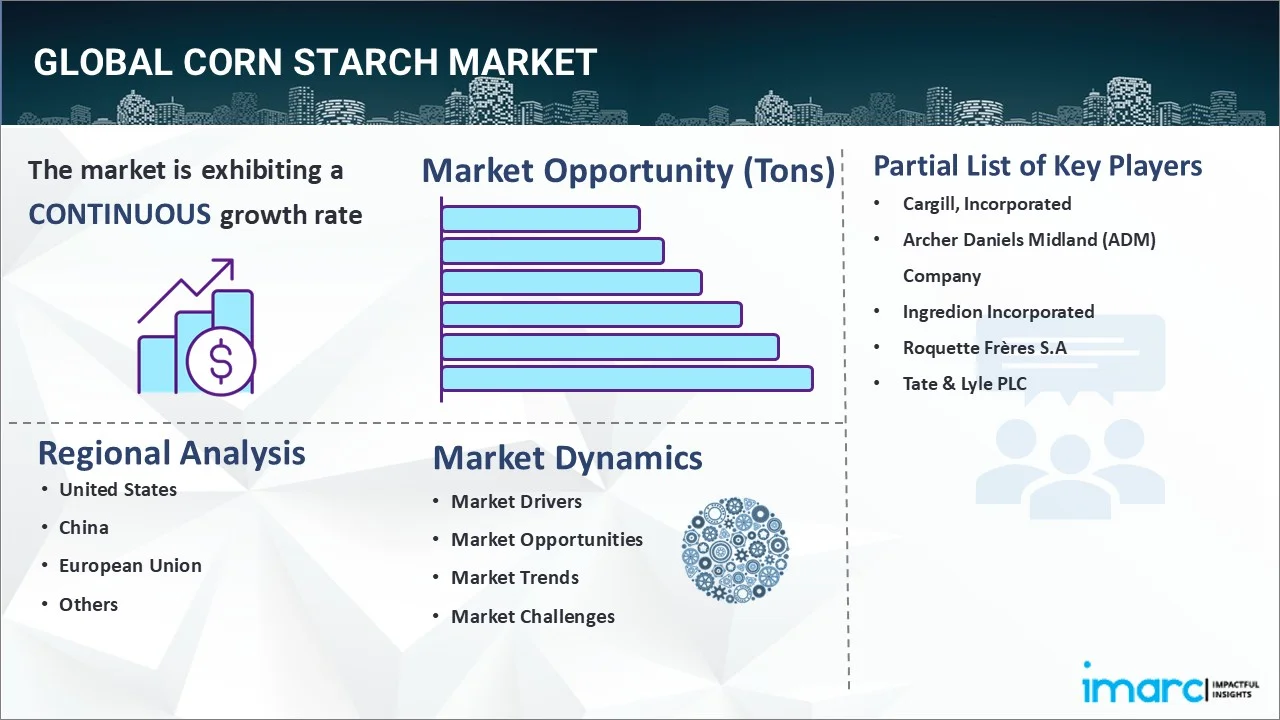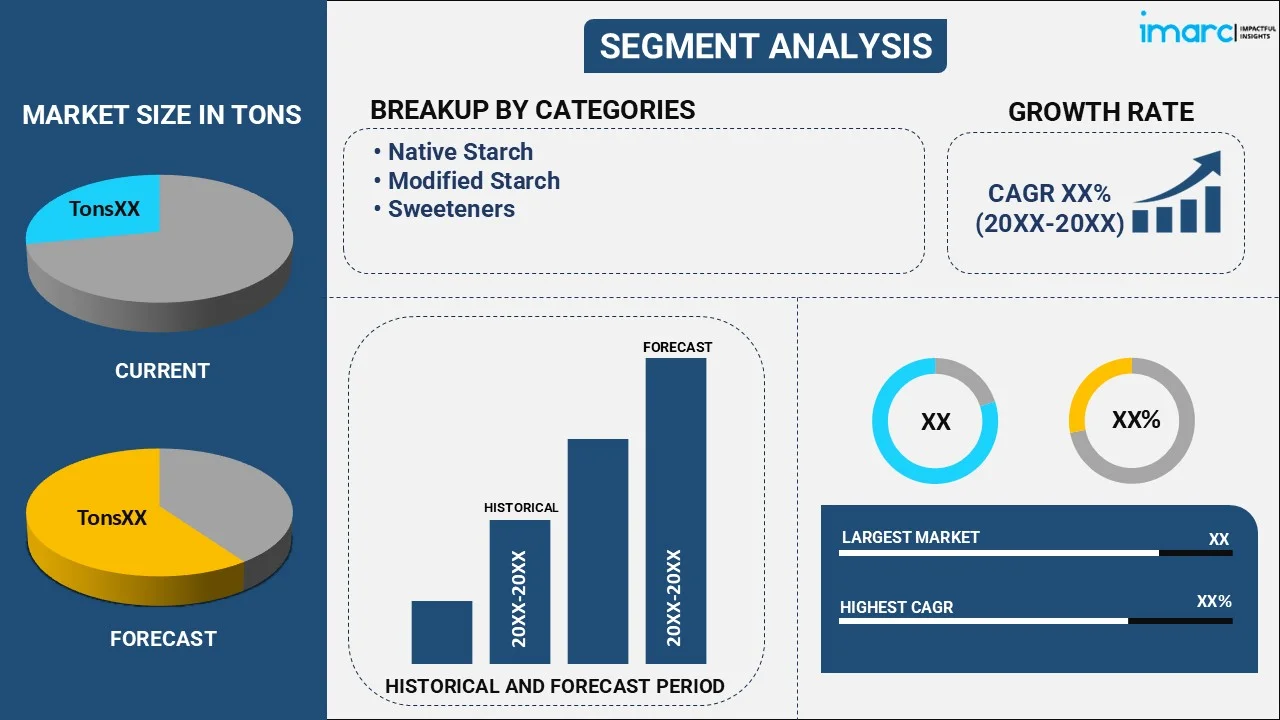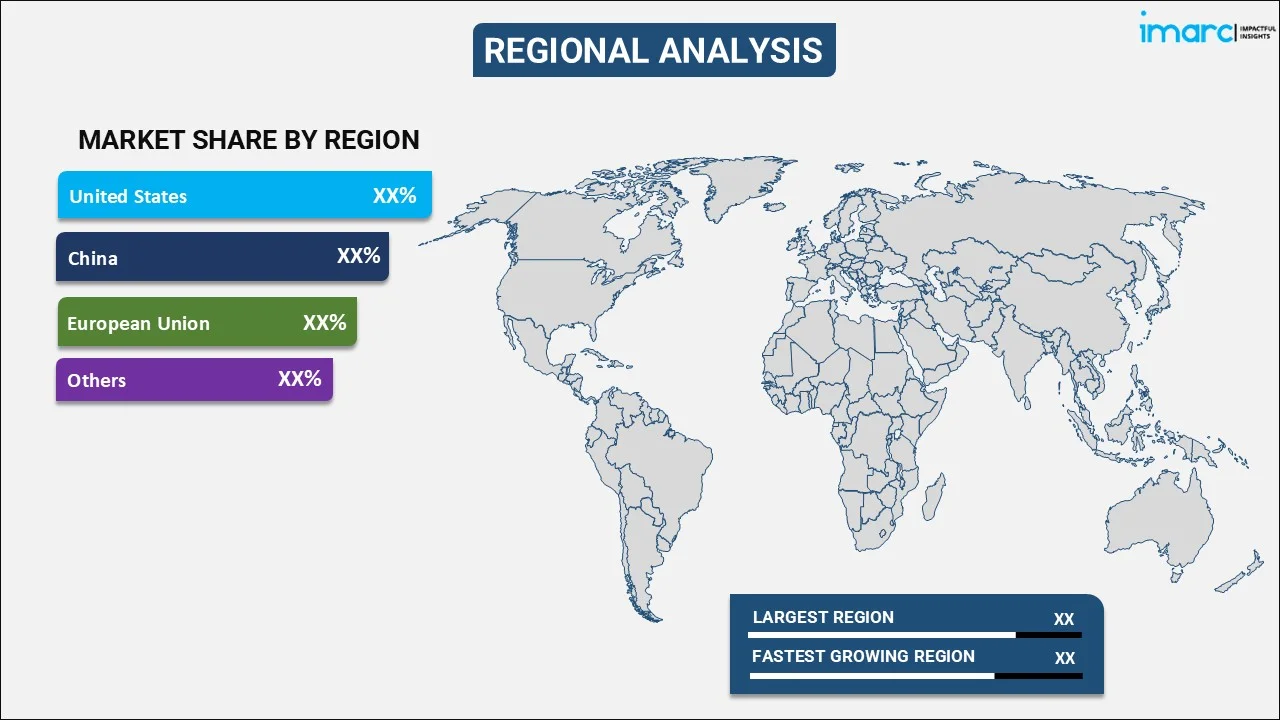
Corn Starch Market Report by Category (Native Starch, Modified Starch, Sweeteners), Application (Food & Beverages, Animal Feed, Pharmaceuticals & Chemicals, Textile, Paper & Corrugates, and Others), and Region 2026-2034
Corn Starch Market Size:
The global corn starch market size reached 90.32 Million Tons in 2025. Looking forward, IMARC Group expects the market to reach 109.38 Million Tons by 2034, exhibiting a growth rate (CAGR) of 2.15% during 2026-2034. The increasing product demand from food and beverage (F&B) sector, advancements in extraction and modification technologies, rising awareness of sustainable practices, rapid globalization and increasing trade activities, and widespread product utilization in the pharmaceutical industry are some of the major factors propelling the market.
|
Report Attribute
|
Key Statistics
|
|---|---|
|
Base Year
|
2025 |
|
Forecast Years
|
2026-2034
|
|
Historical Years
|
2020-2025
|
| Market Size in 2025 | 90.32 Million Tons |
| Market Forecast in 2034 | 109.38 Million Tons |
| Market Growth Rate 2026-2034 | 2.15% |
Corn Starch Market Analysis:
- Market Growth and Size: The market is witnessing steady growth, which can be attributed to its versatile applications across various industries, such as food and beverage (F&B), pharmaceuticals, and textiles. Additionally, the rising demand for convenience food products, along with the increasing use of corn starch as a thickening and stabilizing agent in various products, is strengthening the corn start market growth.
- Major Market Drivers: The growing consumer preferences for natural and organic ingredients in food products are catalyzing the demand for corn starch as a natural thickening and binding agent. Moreover, technological advancements in corn starch production processes, along with expanding applications in non-food sectors like paper and adhesives, are positively influencing the market outlook.
- Key Market Trends: Market trends include the increasing adoption of modified corn starches to enhance product functionality and cater to specific consumer demands. Besides this, sustainability initiatives and the development of eco-friendly corn starch derivatives are gaining traction among manufacturers, aligning with the growing consumer consciousness towards environmental conservation.
- Geographical Trends: United States leads the market, with vast agricultural lands dedicated to corn cultivation. This abundant supply of corn serves as a key raw material for corn starch production, driving down production costs. However, China is emerging as a fast-growing market, driven by incentives provided by governing agencies of the country to support domestic corn production.
- Competitive Landscape: Key players are focusing on providing a wide range of corn starch products tailored as per industrial and consumer applications. They are also investing in research and development (R&D) activities to develop modified and specialty starches catering to specific consumer needs.
- Challenges and Opportunities: While the market faces challenges, such as fluctuations in corn starch market price due to factors like weather conditions and geopolitical tensions, it also encounters opportunities in leveraging technological advancements for product innovations, expanding into untapped markets, and diversifying product portfolios to meet evolving consumer preferences and regulatory requirements.

To get more information on this market Request Sample
Corn Starch Market Trends:
The increasing product adoption in the food and beverage (F&B) sector
The growing demand for cornstarch in the food and beverage (F&B) industry is an important factor propelling the market growth. Corn starch is primarily utilized as an emulsifier, thickening agent, and stabilizer in various food products, such as sauces, soups, desserts, and baby foods. Furthermore, the shifting trend towards processed and packaged foods is acting as another growth-inducing factor. Apart from this, the ability of cornstarch to withstand various processing conditions, like high temperatures and acidic environments, further bolsters its demand among food manufacturers. Additionally, the push for cleaner and natural ingredients favors corn starch, which is perceived as a more natural and less processed alternative to artificial additives. Moreover, it plays an essential role in meeting consumer demand for healthier yet convenient food choices.
The advancements in extraction and modification technologies
Technological advancements in the field of corn starch extraction and modification are playing a pivotal role in driving the market. Newer technologies facilitate greater yield, cost-efficiency, and purity, making the substance more viable for a broader range of applications. In line with this, the introduction of enzymatic processes to carry out more effective isolation and modification of corn starch is positively influencing the market growth. Additionally, the advent of modified starches, which are engineered to have specific functional properties like high heat resistance or slow digestibility, is acting as another growth-inducing factor. Furthermore, these specialized products are providing new opportunities for the utilization of corn starch in various industries, including pharmaceuticals, construction, and textiles. As a result, technology serves as both an enabler and accelerator for the corn starch market, diversifying its uses and improving its overall economic viability.
The rising awareness of sustainable practices
Sustainability is a central business imperative that is significantly impacting various industries, including the corn starch market. Corn starch, being a bio-based and biodegradable material, is well-aligned with this rising tide of environmental awareness. Companies are keen to replace synthetic and petroleum-based materials with more sustainable alternatives, and corn starch fits this preference perfectly. Moreover, its application as a biodegradable plastic, an eco-friendly adhesive, and an ingredient in the development of biofuels makes corn starch an attractive option for those looking to minimize their carbon footprint. Besides this, the increasing governmental regulations on environmental responsibility and the adoption of eco-friendly products are propelling the market growth. Additionally, the implementation of the circular economy model, which emphasizes the sustainable use of resources, also complements the use of renewable materials like corn starch.
Corn Starch Industry Segmentation:
IMARC Group provides an analysis of the key trends in each segment of the global corn starch market report, along with forecasts at the global and country levels for 2026-2034. Our report has categorized the market based on category and application.
Breakup by Category:

To get detailed segment analysis of this market Request Sample
- Native Starch
- Modified Starch
- Sweeteners
Sweeteners dominates the market
The report has provided a detailed breakup and analysis of the market based on category. This includes native starch, modified starch, and sweeteners. According to the report, sweeteners represented the largest segment.
Sweeteners derived from corn starch can be used in a wide range of edible products, including soft drinks, baked goods, cereals, condiments, and processed foods. Their versatility makes them a high-demand ingredient in the food industry. Furthermore, they are more cost-effective than other sweeteners, such as cane sugar, which makes them an attractive choice for food and beverage (F&B) manufacturers. Corn starch-based sweeteners contribute to the preservation and extension of the shelf life of many food products. Their moisture-retaining properties and resistance to microbial growth make them a valuable ingredient in processed foods. Besides this, they provide a sweet taste that balances the flavors of various ingredients, thus making them a preferred choice for formulating products with consistent taste.
Breakup by Application:
- Food & Beverages
- Animal Feed
- Pharmaceuticals & Chemicals
- Textile
- Paper & Corrugates
- Others
Food & beverages hold the largest share in the market
A detailed breakup and analysis of the market based on application has also been provided in the report. This includes food & beverages, animal feed, pharmaceuticals & chemicals, textile, paper & corrugates, and others. According to the report, food & beverages account for the majority of the market share.
Corn starch is a highly versatile ingredient with myriad applications in the food and beverage (F&B) industry. It serves as a thickening agent, stabilizer, and texturizer in numerous products, making it a crucial component in many recipes. Additionally, it is known for its ability to enhance the texture and mouthfeel of various food products. In line with this, corn starch can create smooth and creamy textures in sauces, soups, and desserts, and it is often used to achieve the desired consistency in foods, such as puddings and gravies. Furthermore, it is a common ingredient in a variety of processed foods, including baked goods, snacks, ready-to-eat (RTE) meals, and dairy products. Moreover, corn starch is naturally gluten-free, making it a valuable ingredient for gluten-free and allergen-sensitive consumers.
Breakup by Region:

To get more information on the regional analysis of this market Request Sample
- United States
- China
- European Union
- Others
United States exhibits a clear dominance, accounting for the largest corn starch market share
The market research report has also provided a comprehensive analysis of all the major regional markets, which include United States, China, European Union, and others. According to the report, United States accounted for the largest market share.
The United States (US) has consistently been one of the largest producers of corn, which provides the raw material needed for corn starch production. Additionally, US farmers employ advanced agricultural practices, including the use of genetically modified corn varieties that are optimized for starch content and yield. These practices lead to higher corn production and starch extraction efficiency. Furthermore, the United States has well-developed infrastructure and modern processing facilities for corn starch extraction, including corn wet milling plants that can efficiently process large quantities of corn into starch and related products. Moreover, the US corn starch industry benefits from economies of scale, which result in cost-efficient production. Apart from this, the industry's competitiveness in terms of production costs allows US manufacturers to export corn starch competitively to international markets.
Competitive Landscape:
Leading companies in the corn starch market are diversifying their product offerings to cater to various industries and applications. This includes producing modified starches, sweeteners, and value-added derivatives for use in food, beverages, pharmaceuticals, and industrial applications. Furthermore, several market players are focusing on sustainability to meet consumer demands and reduce their environmental footprint. This involves sustainable sourcing of corn, reducing water and energy consumption in production processes, and implementing eco-friendly packaging solutions. Additionally, top manufacturers are expanding their production and distribution networks to serve international markets by establishing manufacturing facilities or distribution centers in regions with growing demand for corn starch and related products. Moreover, companies are investing in research and innovation to improve product quality, develop innovative applications, and optimize production processes, thereby positively influencing the corn start market size.
The report has provided a comprehensive analysis of the competitive landscape in the market. Detailed profiles of all major companies have also been provided. Some of the key players in the market include:
- Cargill, Incorporated
- Archer Daniels Midland (ADM) Company
- Ingredion Incorporated
- Roquette Frères S.A
- Tate & Lyle PLC
Recent Developments:
- In September 2022, Cargill established a new corn wet mill in Indonesia, which will assist in meeting the growing demand for starches, sweeteners, and feed in Asia.
- In May 2022, Archer Daniels Midland (ADM) Company announced its plans to expand starch production capacity at its Marshal corn processing facility.
- In September 2022, Ingredion Incorporated established a new state-of-the-art sustainable starch manufacturing plant in China.
Corn Starch Market Report Scope:
| Report Features | Details |
|---|---|
| Base Year of the Analysis | 2025 |
| Historical Period | 2020-2025 |
| Forecast Period | 2026-2034 |
| Units | Million Tons, Billion USD |
| Scope of the Report | Exploration of Historical and Forecast Trends, Industry Catalysts and Challenges, Segment-Wise Historical and Predictive Market Assessment:
|
| Categories Covered | Native Starch, Modified Starch, Sweeteners |
| Applications Covered | Food & Beverages, Animal Feed, Pharmaceuticals & Chemicals, Textile, Paper & Corrugates, Others |
| Regions Covered | United States, China, European Union, Others |
| Companies Covered | Cargill, Incorporated, Archer Daniels Midland (ADM) Company, Ingredion Incorporated, Roquette Frères S.A, Tate & Lyle PLC, etc. |
| Customization Scope | 10% Free Customization |
| Post-Sale Analyst Support | 10-12 Weeks |
| Delivery Format | PDF and Excel through Email (We can also provide the editable version of the report in PPT/Word format on special request) |
Key Benefits for Stakeholders:
- IMARC’s industry report offers a comprehensive quantitative analysis of various market segments, historical and current market trends, market forecasts, and dynamics of the corn starch market from 2020-2034.
- The research report provides the latest information on the market drivers, challenges, and opportunities in the global corn starch market.
- The study maps the leading, as well as the fastest-growing, regional markets. It further enables stakeholders to identify the key country-level markets as well as the fastest-growing markets.
- Porter's five forces analysis assist stakeholders in assessing the impact of new entrants, competitive rivalry, supplier power, buyer power, and the threat of substitution. It helps stakeholders to analyze the level of competition within the corn starch industry and its attractiveness.
- Competitive landscape allows stakeholders to understand their competitive environment and provides an insight into the current positions of key players in the market.
Key Questions Answered in This Report
The global corn starch market reached a volume of 90.32 Million Tons in 2025.
We expect the global corn starch market to exhibit a CAGR of 2.15% during 2026-2034.
The rising demand for processed food items, along with the increasing adoption of corn starch for gum molding, thickening sauces, and as a viscosity-control agent for binding baking ingredients, is primarily driving the global corn starch market.
The sudden outbreak of the COVID-19 pandemic has led to the changing consumer inclination from conventional brick-and-mortar distribution channels towards online retail platforms for the purchase of corn starch.
Based on the category, the global corn starch market has been bifurcated into native starch, modified starch, and sweeteners. Currently, sweeteners hold the largest market share.
Based on the application, the global corn starch market can be segmented into food & beverages, animal feed, pharmaceuticals & chemicals, textile, paper & corrugates, and others. Among these, the food and beverage (F&B) sector accounts for the majority of the total market share.
On a regional level, the market has been classified into United States, China, European Union, and others, where the United States currently dominates the global market.
Some of the major players in the global corn starch market include Cargill, Incorporated, Archer Daniels Midland (ADM) Company, Ingredion Incorporated, Roquette Frères S.A, Tate & Lyle PLC, etc.
Need more help?
- Speak to our experienced analysts for insights on the current market scenarios.
- Include additional segments and countries to customize the report as per your requirement.
- Gain an unparalleled competitive advantage in your domain by understanding how to utilize the report and positively impacting your operations and revenue.
- For further assistance, please connect with our analysts.
 Request Customization
Request Customization
 Speak to an Analyst
Speak to an Analyst
 Request Brochure
Request Brochure
 Inquire Before Buying
Inquire Before Buying




.webp)




.webp)












